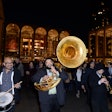In 2011, the event industry experienced a seismic shift toward experiences with relevant content. Brand messaging, continuity, and consistency became paramount, and organizations moved away from unnecessary glitz, glamour, and their accompanying spending in favor of cohesive, targeted, on-brand experiences. Companies could no longer rely exclusively on entertainment and the “wow” factor to engage attendees and change behavior. Substance-driven experiences became the “wow” factor, and it was very effective.
Over the last several years, media reports have been published (such as David H. Freedman’s Inc.com article, “The Future of Advertising Is Here” on August 1, 2005) that estimate that the number of brand messages audiences consume each day makes them numb to the vast majority. Target audiences can no longer accept empty branding; rather, they require meaningful, actionable messages that are on brand and on point across all marketing initiatives—including events, public relations, and marketing communications. Companies are recognizing the need for authentic, focused content that supports and drives the branding so that all messages are strategically aligned.
The economic downturn has highlighted the importance of ensuring that brand messaging is the same across all platforms. Because companies are focused on spending smarter, every dollar needs to have focused impact, as companies don’t have the resources to promote their brand with multiple messages. Furthermore, creating brand consistencies leads to cost efficiencies. There’s no need to reinvent the wheel—messaging elements can be repurposed across many platforms, resulting in greater brand immersion, more powerful messages to drive behavior, and a stronger ROI.
To accomplish this difficult but not impossible task, more communications agencies are collaborating closely with their clients to ensure that creative pieces, messaging, scenic elements, event technologies, and digital engagement programs support the goal of brand continuity. For instance, client branding and messaging extend from pre-event communications to event signage to programming to environmental design to entertainment to accommodations to post-event surveys to social media, and everywhere in between.
An event is no longer just an event, but a cohesive experience that immerses the target audience with brand authenticity and consistent messaging, by design, with no clear beginning, middle, or end. Beyond that, event teams are working with PR, marketing communications, advertising, and sales teams to shape the messaging and create cohesive brand experiences that occur beyond just a live event, a press release, a news story, or printed collateral, and integrate all those elements and more. With this cross-platform strategy, companies can reach their audiences no matter how they consume the message.
We are at a tipping point, and the trend of establishing brand continuity and consistency throughout the entire experience will become a cost of entry for event producers in 2012 and beyond. The traditional definition of live events indicates that there’s a start and a stop. What we do is create an ongoing experience that has lasting impact well before the first day of an event, and long after people go home. Companies that employ strategically focused cross-platform strategies will thrive, and those that ignore this critical trend will be left behind.
—Scott Cullather, founder and managing partner, inVNT, New York, @scullather



















